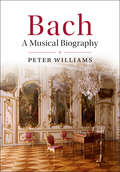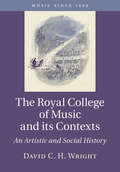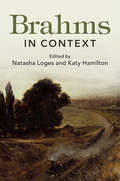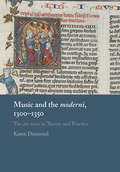- Table View
- List View
Mozart Studies 2
by Simon P. KeefeCultural, historical and reception-related contexts are central to understanding Mozart, one of the greatest and most famous musicians of all time. Widening and refining the lens through which the composer is viewed, the essays in Mozart Studies 2 focus on themes, issues, works and repertories perennially popular among Mozart scholars of all kinds, pointing to areas primed for future study and also suitable for investigation by musicians outside the scholarly community. Following on from the first Mozart Studies volume, internationally renowned contributors bring new perspectives to bear on many of Mozart's most popular works, as well as the composer's letters, biography, and reception. Chapters are grouped according to topics covered and collectively affirm the vitality of Mozart scholarship and the significant role it continues to play in defining and redefining musicological priorities in general.
Music in Context: The Operas of Maurice Ravel
by Emily KilpatrickMaurice Ravel's operas L'Heure espagnole (1907/1911) and L'Enfant et les sortilèges (1919–25) are pivotal works in the composer's relatively small œuvre. Emerging from periods shaped by very distinct musical concerns and historical circumstances, these two vastly different works nevertheless share qualities that reveal the heart of Ravel's compositional aesthetic. In this comprehensive study, Emily Kilpatrick unites musical, literary, biographical and cultural perspectives to shed new light on Ravel's operas. In documenting the operas' history, setting them within the cultural canvas of their creation and pursuing diverse strands of analytical and thematic exploration, Kilpatrick reveals crucial aspects of the composer's working life: his approach to creative collaboration, his responsiveness to cultural, aesthetic and musical debate, and the centrality of language and literature in his compositional practice. The first study of its kind, this book is an invaluable resource for students, specialists, opera-goers and devotees of French music.
The History of the Erard Piano and Harp in Letters and Documents, 1785-1959
by Robert Adelson Alain Roudier Jenny Nex Laure Barthel Michel Foussard Robert Adelson Alain Roudier Jenny Nex Laure BarthelSébastien Erard and the firm that carried his name are seminal in the history of musical instruments. Erard's inventions - especially the double escapement for the piano and the double-action for the harp - have had an enormous impact on instruments and musical life and are still at the foundation of piano and harp building today. The recently discovered archives of the Erard piano and harp building firm are perhaps the largest and most complete record of musical instrument making anywhere, containing never-before-published correspondence from musicians including Mendelssohn, Liszt and Fauré. These volumes present the archive's records and documents in two parts, the first relating to inventions, business, composers and performers and the second to the Erard family correspondence. In both the original French and with English translations, the documents offer fascinating insights into the musical landscape of Europe from the start of Erard's career in 1785 to the closure of the firm in 1959.
Music Since 1900: Luigi Nono
by Carola Nielinger-VakilThe anti-fascist cantata Il canto sospeso, the string quartet Fragmente - Stille, an Diotima and the 'Tragedy of Listening' Prometeo cemented Luigi Nono's place in music history. In this study, Carola Nielinger-Vakil examines these major works in the context of Nono's amalgamation of avant-garde composition with Communist political engagement. Part I discusses Il canto sospeso in the context of all of Nono's anti-fascist pieces, from the unfinished Fučik project (1951) to Ricorda cosa ti hanno fatto in Auschwitz (1966). Nielinger-Vakil explores Nono's position at the Darmstadt Music Courses, the evolution of his compositional technique, his penchant for music theatre and his use of spatial and electronic techniques to set the composer and his works against the diverging circumstances in Italy and Germany after 1945. Part II further examines these concerns and shows how they live on in Nono's work after 1975, culminating in a thorough analysis of Prometeo.
The Cambridge Companion to Jewish Music
by Joshua S. WaldenThe term 'Jewish music' has conveyed complex and diverse meanings for people around the world across hundreds of years. This accessible and comprehensive Companion is a key resource for students, scholars, and everyone with an interest in the global history of Jewish music. Leading international experts introduce the broad range of genres found in Jewish music from the biblical era to the present day, including classical, religious, folk, popular, and dance music. Presenting a range of fresh perspectives on the subject, the chapters explore Jewish liturgy, Klezmer, music in Israel, the music of Yiddish theatre and cinema, and classical music from the Jewish Enlightenment through to the postmodern era. Additional contributions set Jewish music in context and offer an overview of the broader issues that arise in its study, such as questions of Diaspora, ontology, economics, and the history of sound technologies.
Schoenberg and Hollywood Modernism
by Kenneth H. MarcusSchoenberg is often viewed as an isolated composer who was ill-at-ease in exile. In this book Kenneth H. Marcus shows that in fact Schoenberg's connections to Hollywood ran deep, and most of the composer's exile compositions had some connection to the cultural and intellectual environment in which he found himself. He was friends with numerous successful film industry figures, including George Gershwin, Oscar Levant, David Raksin and Alfred Newman, and each contributed to the composer's life and work in different ways: helping him to obtain students, making recordings of his music, and arranging commissions. While teaching at both the University of Southern California and the University of California, Los Angeles, Schoenberg was able to bridge two utterly different worlds: the film industry and the academy. Marcus shows that alongside Schoenberg's vital impact upon Southern California Modernism through his pedagogy, compositions and texts, he also taught students who became central to American musical modernism, including John Cage and Lou Harrison.
Schubert's Late Music
by Bodley, Lorraine Byrne and Horton, Julian Lorraine Byrne Bodley Julian HortonSchubert's late music has proved pivotal for the development of diverse fields of musical scholarship, from biography and music history to the theory of harmony. This collection addresses current issues in Schubert studies including compositional technique, the topical issue of 'late' style, tonal strategy and form in the composer's instrumental music, and musical readings of the 'postmodern' Schubert. Offering fresh approaches to Schubert's instrumental and vocal works and their reception, this book argues that the music that the composer produced from 1822–8 is central to a paradigm shift in the history of music during the nineteenth century. The contributors provide a timely reassessment of Schubert's legacy, assembling a portrait of the composer that is very different from the sentimental Schubert permeating nineteenth-century culture and the postmodern Schubert of more recent literature.
Music Since 1900: Transformations of Musical Modernism
by Guldbrandsen, Erling E. and Johnson, Julian Erling E. Guldbrandsen Julian JohnsonProfound transformations in the composition, performance and reception of modernist music have taken place in recent decades. This collection brings fresh perspectives to bear upon key questions surrounding the forms that musical modernism takes today, how modern music is performed and heard, and its relationship to earlier music. In sixteen chapters, leading figures in the field and emerging scholars examine modernist music from the inside, in terms of changing practices of composition, musical materials and overarching aesthetic principles, and from the outside, in terms of the changing contextual frameworks in which musical modernism has taken place and been understood. Shaped by a 'rehearing' of modernist music, the picture that emerges redraws the map of musical modernism as a whole and presents a full-scale re-evaluation of what the modernist movement has all been about.
Harmony in Beethoven
by David DamschroderDavid Damschroder's ongoing reformulation of harmonic theory continues with a dynamic exploration of how Beethoven molded and arranged chords to convey bold conceptions. This book's introductory chapters are organized in the manner of a nineteenth-century Harmonielehre, with individual considerations of the tonal system's key features illustrated by easy-to-comprehend block-chord examples derived from Beethoven's piano sonatas. In the masterworks section that follows, Damschroder presents detailed analyses of movements from the symphonies, piano and violin sonatas, and string quartets, and compares his outcomes with those of other analysts, including William E. Caplin, Robert Gauldin, Nicholas Marston, William J. Mitchell, Frank Samarotto, and Janet Schmalfeldt. Expanding upon analytical practices from the eighteenth and nineteenth centuries and strongly influenced by Schenkerian principles, this fresh perspective offers a stark contrast to conventional harmonic analysis - both in terms of how Roman numerals are deployed and how musical processes are described in words.
Expanding the Horizon of Electroacoustic Music Analysis
by Emmerson, Simon and Landy, Leigh Simon Emmerson Leigh LandyInnovations in music technology bring with them a new set of challenges for describing and understanding the electroacoustic repertoire. This edited collection presents a state-of-the-art overview of analysis methods for electroacoustic music in this rapidly developing field. The first part of the book explains the needs of differing electroacoustic genres and puts forward a template for the analysis of electroacoustic music. Part II discusses the latest ideas in the field and the challenges associated with new technologies, while Part III explores how analyses have harnessed the new forces of multimedia, and includes an introduction to new software programme EAnalysis, which was created by the editors as the result of an Arts and Humanities Research Council grant. The final part of the book demonstrates these new methods in action, with analyses of key electroacoustic works from a wide range of genres and sources.
The Cambridge Companion to The Singer-Songwriter
by Williams, Katherine and Williams, Justin A. Katherine Williams Justin A. WilliamsMost often associated with modern artists such as Bob Dylan, Elton John, Don McLean, Neil Diamond, and Carole King, the singer-songwriter tradition in fact has a long and complex history dating back to the medieval troubadour and earlier. This Companion explains the historical contexts, musical analyses, and theoretical frameworks of the singer-songwriter tradition. Divided into five parts, the book explores the tradition in the context of issues including authenticity, gender, queer studies, musical analysis, and performance. The contributors reveal how the tradition has been expressed around the world and throughout its history to the present day. Essential reading for enthusiasts, practitioners, students, and scholars, this book features case studies of a wide range of both well and lesser-known singer-songwriters, from Thomas d'Urfey through to Carole King and Kanye West.
Handel on the Stage
by David KimbellOf all the great composers of the eighteenth century, Handel was the supreme cosmopolitan, an early and extraordinarily successful example of a freelance composer. For thirty years the opera-house was the principal focus of his creative work and he composed more than forty operas over this period. In this book, David Kimbell sets Handel's operas in their biographical and cultural contexts. He explores the circumstances in which they were composed and performed, the librettos that were prepared for Handel, and what they tell us about his and his audience's values and the music he composed for them. Remarkably no Handel operas were staged for a period of 170 years between 1754 and the 1920s. The final chapter in this book reveals the differences and similarities between how Handel's operas were performed in his time and ours.
Mozart’s Music of Friends
by Klorman, Edward and McCreless, Patrick Edward Klorman Patrick MccrelessIn 1829 Goethe famously described the string quartet as 'a conversation among four intelligent people'. Inspired by this metaphor, Edward Klorman's study draws on a wide variety of documentary and iconographic sources to explore Mozart's chamber works as 'the music of friends'. Illuminating the meanings and historical foundations of comparisons between chamber music and social interplay, Klorman infuses the analysis of sonata form and phrase rhythm with a performer's sensibility. He develops a new analytical method called multiple agency that interprets the various players within an ensemble as participants in stylized social intercourse - characters capable of surprising, seducing, outwitting, and even deceiving one another musically. This book is accompanied by online resources that include original recordings performed by the author and other musicians, as well as video analyses that invite the reader to experience the interplay in time, as if from within the ensemble.
Bach
by Peter WilliamsBach, like Shakespeare, is known largely by his works, exceptional in quantity as well as quality, and only a few original documents convey any idea of his life and character. Peter Williams's 2003 look at Bach's biography asks many questions about the so-called evidence. What was he like as a young man, as a father, as an ageing church servant? What were his preoccupations? What music did he know and how did he compose and perform such an amazing amount of music? Was he a disappointed man? Reading the available documentation critically, especially from the viewpoint of a performer, and going back to the first substantial 'biography' of Bach, namely his Obituary, Williams suggests new interpretations of the composer's life and his work. In addition, he asks if our understanding of Bach has been hindered by the unremitting deference displayed towards him since his death.
The Cambridge Companion to Medievalism (Cambridge Companions to Culture)
by Louise D’arcensMedievalism - the creative interpretation or recreation of the European Middle Ages - has had a major presence in the cultural memory of the modern West, and has grown in scale to become a global phenomenon. Countless examples across aesthetic, material and political domains reveal that the medieval period has long provided a fund of images and ideas that have been vital to defining 'the modern'. Bringing together local, national and global examples and tracing medievalism's unpredictable course from early modern poetry to contemporary digital culture, this authoritative Companion offers a panoramic view of the historical, aesthetic, ideological and conceptual dimensions of this phenomenon. It showcases a range of critical positions and approaches to discussing medievalism, from more 'traditional' historicist and close-reading practices through to theoretically engaged methods. It also acquaints readers with key terms and provides them with a sophisticated conceptual vocabulary for discussing the medieval afterlife in the modern. Features a historical span of essays from the early modern era to the present, surveying what the Middle Ages has meant to various later periods Ranges across local and national medievalism to colonial and global medievalism, tracing its development from a European to a global phenomenon Examines medievalism through a diversity of media including literature, architecture, music, film and videogames, demonstrating its many forms and broad expressive range
The Cambridge Companion to Percussion
by Russell HartenbergerPercussion music is both the oldest and most recent of musical genres and exists in diverse forms throughout the world. This Companion explores percussion and rhythm from the perspectives of performers, composers, conductors, instrument builders, scholars, and cognitive scientists. Topics covered include percussion in symphony orchestras from the nineteenth century to today and the development of percussion instruments in chapters on the marimba revolution, the percussion industry, drum machines, and the effect of acoustics. Chapters also investigate drum set playing and the influences of world music on Western percussion, and outline the roles of percussionists as composers, conductors, soloists, chamber musicians, and theatrical performers. Developments in scientific research are explored in chapters on the perception of sound and the evolution of musical rhythm. This book will be a valuable resource for students, percussionists, and all those who want a deeper understanding of percussion music and rhythm.
Schumann’s Music and E. T. A. Hoffmann’s Fiction
by John MacauslanFour of Schumann's great masterpieces of the 1830s - Carnaval, Fantasiestücke, Kreisleriana and Nachtstücke - are connected to the fiction of E. T. A. Hoffmann. In this book, John MacAuslan traces Schumann's stylistic shifts during this period to offer insights into the expressive musical patterns that give shape, energy and individuality to each work. MacAuslan also relates the works to Schumann's reception of Bach, Beethoven, Novalis and Jean Paul, and focuses on primary sources in his wide-ranging discussion of the broader intellectual and aesthetic contexts. Uncovering lines of influence from Schumann's reading to his writings, and reflecting on how the aesthetic concepts involved might be used today, this book transforms the way Schumann's music and its literary connections can be understood and will be essential reading for musicologists, performers and listeners with an interest in Schumann, early nineteenth-century music and German Romantic culture.
Music Since 1900: The Graph Music of Morton Feldman
by David ClineMorton Feldman is widely regarded as one of America's greatest composers. His music is famously idiosyncratic, but, in many cases, the way he presented it is also unusual because, in the 1950s and 1960s, he often composed in non-standard musical notations, including a groundbreaking variety on graph paper that facilitated deliberately imprecise specifications of pitch and, at times, other musical parameters. Feldman used this notation, intermittently, over seventeen years, producing numerous graph works that invite analysis as an evolving series. Taking this approach, David Cline marshals a wide range of source materials - many previously unpublished - in clarifying the ideology, organisation and generative history of these graphs and their formative role in the chronicle of post-war music. This assists in pinpointing connections with Feldman's compositions in other formats, works by other composers, notably John Cage, and contemporary currents in painting. Performance practice is examined through analysis of Feldman's non-notated preferences and David Tudor's celebrated interpretations.
Instrumentalists and Renaissance Culture, 1420–1600
by Coelho, Victor and Polk, Keith Victor Coelho Keith PolkThis innovative and multi-layered study of the music and culture of Renaissance instrumentalists spans the early institutionalization of instrumental music from c. 1420 to the rise of the basso continuo and newer roles for instrumentalists around 1600. Employing a broad cultural narrative interwoven with detailed case studies, close readings of eighteen essential musical sources, and analysis of musical images, Victor Coelho and Keith Polk show that instrumental music formed a vital and dynamic element in the artistic landscape, from rote function to creative fantasy. Instrumentalists occupied a central role in courtly ceremonies and private social rituals during the Renaissance, and banquets, dances, processions, religious celebrations and weddings all required their participation, regardless of social class. Instrumental genres were highly diverse artistic creations, from polyphonic repertories revealing knowledge of notated styles, to improvisation and flexible practices. Understanding the contributions of instrumentalists is essential for any accurate assessment of Renaissance culture.
Ernest Bloch Studies
by Alexander Knapp Norman SolomonErnest Bloch left his native Switzerland to settle in the United States in 1916. One of the great twentieth-century composers, he was influenced by a range of genres and styles - Jewish, American and Swiss - and his works reflect his lifelong struggle with his identity. Drawing on firsthand recollections of relatives and others who knew and worked with the composer, this collection is the most comprehensive study to date of Bloch's life, musical achievement and reception. Contributors present the latest research on Bloch's works and compositional practice, including studies of his Avodath Hakodesh (Sacred Service), violin pieces such as Nigun, the symphonic Schelomo, and the opera Macbeth. Setting the quality and significance of Bloch's output in its historical and cultural contexts, this book provides scholarly analyses as well as a full chronology, list of online resources, catalogue of published and unpublished works, and selected further reading.
Pierre Boulez Studies
by Edward Campbell Peter O’haganPierre Boulez is acknowledged as one of the most important composers in contemporary musical life. This collection explores his works, influence, reception and legacy, shedding new light on Boulez's music and its historical and cultural contexts. In two sections that focus firstly on the context of the 1940s and 1950s and secondly on the development of the composer's style, the contributors address recurring themes such as Boulez's approach to the serial principle and the related issues of form and large-scale structure. Featuring excerpts from Boulez's correspondence with a range of his contemporaries here published for the first time, the book illuminates both Boulez's relationship with them and his thinking concerning the challenges which confronted both him and other leading figures of the European avant-garde. In the final section, three chapters examine Boulez's relationship with audiences in the United Kingdom, and the development of the appreciation of his music.
The Romantic Overture and Musical Form from Rossini to Wagner
by Moortele Steven VandeIn this book Steven Vande Moortele offers a comprehensive account of operatic and concert overtures in continental Europe between 1815 and 1850. Discussing a broad range of works by German, French, and Italian composers, it is at once an investigation of the Romantic overture within the context of mid-nineteenth century musical culture and an analytical study that focuses on aspects of large-scale formal organization in the overture genre. While the book draws extensively upon the recent achievements of the 'new Formenlehre', it does not use the overture merely as a vehicle for a theory of romantic form, but rather takes an analytical approach that engages with individual works in their generic context.
The Royal College of Music and its Contexts: An Artistic and Social History (Music since 1900)
by David C. WrightLocated between the great Victorian museums of South Kensington and the Royal Albert Hall, the Royal College of Music, founded in 1883, has been a central influence on British musical life ever since. This wide-ranging account places the College within its musical and educational environments. It argues that the RCM's significance lies not only in its famous performers and composers, but also the generations of its more anonymous former students who have done so much to improve the musical life of the localities in which they have worked as teachers and animateurs. As a cultural history, this account also captures how significantly society's consumption of music - from new technologies to the altered perspectives of historical and world musics - has changed since the College was founded, and how very different our points of musical reference now are. This study traces the effects of such developments on the College's work.
Brahms in Context (Composers in Context)
by Natasha Loges Katy HamiltonBrahms in Context offers a fresh perspective on the much-admired nineteenth-century German composer. Including thirty-nine chapters on historical, social and cultural contexts, the book brings together internationally renowned experts in music, law, science, art history and other areas, including many figures whose work is appearing in English for the first time. The essays are accessibly written, with short reading lists aimed at music students and educators. The book opens with personal topics including Brahms's Hamburg childhood, his move to Vienna, and his rich social life. It considers professional matters from finance to publishing and copyright; the musicians who shaped and transmitted his works; and the larger musical styles which influenced him. Casting the net wider, other essays embrace politics, religion, literature, philosophy, art, and science. The book closes with chapters on reception, including recordings, historical performance, his compositional legacy, and a reflection on the power of composer myths.
Music and the moderni, 1300–1350: The ars nova in Theory and Practice
by Karen DesmondMusic theorists labelled the musical art of the 1330s and 1340s as 'new' and 'modern'. A close reading of writings on music theory and the polyphonic repertory from the first half of the fourteenth century reveals a modern musical art that arose due to specific innovations in music notation. The French ars nova employed as its theoretical fundament a new system for arranging musical time proposed by the astronomer and mathematician Jean des Murs. Challenging prevailing accounts of the ars nova, this book presents the 'new art' within the intellectual context of its time, revises the datings of Jean des Murs's writings on music theory, and presents the intersection of theory and practice for a crucial era in the history of music. Through contemporaneous accounts, Desmond explores how individuals were involved in 'changing' music in early fourteenth-century France, and the technical developments they pursued that precipitated this stylistic change.




